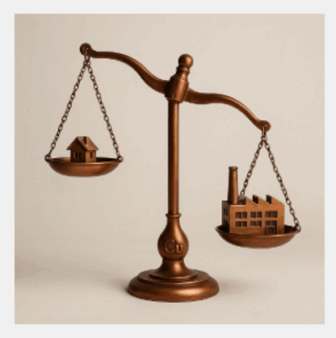How a 50% duty on semifinished copper drifts past consumers and lands squarely on coil makers, lineset extruders, and the distributors who serve them.
The drama that wasn’t, at least for homeowners
When the White House dropped its Section 232 tariff proclamation on July 31, slapping a 50% duty on copper pipe, tube, wire, rod, and sheet effective August 1, it sounded dire for anyone building or remodeling. Markets certainly braced for pain: COMEX futures had sprinted past $5.75/lb. in July as traders front ran a rumored “universal” tariff. Then the text arrived and refined cathode was exempt. Prices promptly fell more than twenty percent, the sharpest one day drop in COMEX history.
Even so, a duty is a duty. What does it mean for housing costs? The answer: not much. A single family home contains about 439 lb. of copper in wiring, plumbing, appliances, and HVAC. Plug that weight into today’s $4.41/lb. spot and you get roughly $1,940 in copper value. Add the tariff to the 30% share that comes in as semifinished goods and the total climbs to $2,228, an $83 bump on a $300,000 build. That is just three one hundredths of a percent of the selling price. No builder is losing sleep over it, and buyers will never notice.
A quick primer on the new 232 action
Section 232 of the Trade Expansion Act of 1962 gives the president wide latitude to restrict imports that threaten national security. In this case the Commerce Department recommended tariffs to shore up the domestic copper rolling and extrusion industry, which has been bleeding market share for two decades. The proclamation imposes a flat 50% duty on the semifinished products listed in its annex. Upstream materials, ores, concentrates, cathodes, anodes, and scrap, remain dutyfree, at least for now.
The duty applies to copper content only, so brass rod and plated products pay duty on the copper fraction, while their zinc, tin, or steel content is assessed at existing rates. Commerce must revisit refined copper by mid2026 and decide whether staged tariffs are warranted.
Why prices spiked, then cratered
Traders spent June and July arbitraging a potential “copper island”: if both refined metal and downstream goods were taxed, U.S. prices would have to clear a higher cost floor than London Metal Exchange (LME) prices. Imports surged, warehouse stocks ballooned, and COMEX traded at a 28% premium to LME. When cathode won its exemption, the logic evaporated and the COMEX premium unwound in hours, carving out the vertical drop you see in the chart. Spot values have since found a new band just above $4.40/lb., roughly where they sat before the speculation.
For OEMs, though, the party is over. They still need semifinished copper, especially tube and smalldiameter rod, no matter where cathode settles.
Where the pain lands: HVAC coils, linesets, and motors
A typical unitary air conditioner or heat pump contains about 52 lb. of copper in its coils, compressor windings, and connecting stubs. If 30% of that metal is sourced as imported tube or rod, the duty adds a hair over $12 per outdoor unit at today’s spot. That is not fatal, but it arrives on top of July’s price spike, freight chaos, and the lingering cost of R410A and R32 transitions. Margins in unitary equipment often live in the high single digits; a $12 swing can erase an OEM’s quarterly target if it cannot be passed through quickly.
Lineset extruders feel an even tighter squeeze. Most rely on imported rod to feed their weldfree continuous tube processes. The tariff hits that rod directly, and domestic rod prices are already drifting up in response to sudden demand. Distributors holding summer priced inventory may enjoy a brief windfall, but their replacement cost just jumped.
The global chess moves have started
International trade partners are not letting the tariff go unanswered. On July 24 the European Commission endorsed a package of countermeasures that includes extra duties of up to 30% on selected U.S. electrical components and cable assemblies if talks fail. China, meanwhile, sidestepped a headline response yet quietly tightened environmental certifications on U.S. copper scrap, a de facto quota that could choke a supply valve U.S. recyclers rely on. The chess game is young, but every new move threatens to redirect global metal flows and trigger fresh volatility.
What distributors and OEMs can do now
- Audit contract language – Verify whether your supply or sales agreements define copper adders, tariff passthroughs, or dutyinclusive pricing. Tighten vague clauses before bids go out.
- Review inventory mix – Shortdated inventory gains value when tariffs land. Know which SKUs carry large copper bills of material and adjust safety stocks accordingly.
- Consider forward buys – If your bank line allows, lock in extra rod or tube now while spot prices hover near preannouncement levels.
- Dualsource where feasible – Line up a domestic tube mill, even if pricing is higher, so you can hedge supply risk. Queue early to secure tonnage.
- Explore substitution – Aluminum microchannel coils and PEXA linesets are proven. Every pound skipped is a pound shielded from duty risk.
- Update quoting cadence – Shorten bid validity windows and add copper surcharges that adjust weekly or monthly.
- Hedge margins, not prices – Futures contracts track cathode, which is tariff free. A better hedge might be a spread trade: long COMEX cathode, short LME cathode, capturing any renewed U.S. premium that could bleed into semifinished products.
- Stay close to policy channels – HARDI’s government affairs alerts, AHRI’s 232 working group, and EU public comment dockets are early signals of rule tweaks.
Want a deeper dive? We’re gathering real-world data on how distributors and OEMs are handling copper duties, hedging, and substitution. If you’d like to benchmark your approach, or share a tactic that’s working, let’s talk. CMG’s consulting team can run a quick diagnostic, highlight gaps, and outline practical next steps. Email me or book a 20-minute call.
As always, we appreciate your comments and support.
